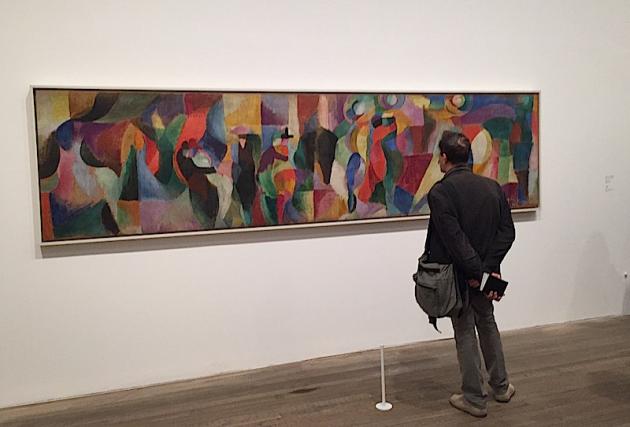The Tate has an active exhibitions programme designed to rediscover and explore key figures in the story of Modern Art especially women. Both exhibition spaces at Tate Modern are now dedicated to women artists: the first the contemporary Marlene Dumas and the second, which opens today, to Sonia Delaunay.
Russian born Sonia Delaunay was always seen as less important as her husband Robert, especially as she devoted a lot of her creative energy to applied arts: textiles, fashion, costume design, interiors which traditionally has been seen as a lesser form of art and also because after Robert’s untimely death in 1941, she devoted much of her time to preserving and promoting his work.
Today, this multi-faceted approach is back in vogue with many artists diversifying their talents and establishing themselves in different media such as Sarah Lucas and Tracey Emin. The show at the Tate goes a long way to redress the balance towards the Delaunays and to celebrate the breadth of Sonia’s talent establishing her as a pioneer. She was a highly intelligent, well-read, creative talent embracing all aspects of the artistic milieu that she inhabited – avant-garde in the true meaning of the term.
The show is essentially organized chronologically. Sonia Delaunay was born in 1885 as Sara Stern to Jewish parents in Odessa. At the age of five, she was adopted by her wealthy uncle, Henri Terk, and her name was changed to Sofia Terk although she was always known as Sonia. She was highly educated and spoke four languages. In 1904, she attended the Art Academy in Karlruhe, Germany and two years later moved to Paris where she continued her studies at the Academie de la Palette. Modern Art in Paris was at a crucial point: the first Fauvist exhibition had just taken place at the Salon d’Automne. Her early works show the influence of Paul Gauguin and the German Expressionists such as the Die Brucke group. Yellow Nude 1908 is a strikingly mature work with its vivid colours, bold outlines and areas of patterning.
She met and married Robert Delaunay in 1910. This was her second marriage, her first having been a mutually convenient arrangement with the homosexual dealer Wilhelm Uhde. Robert’s influences had been impressionism and cubism but together they moved towards abstraction. They developed a theory of simultaneous colour-contrasts that they called simultanism although it has become better known as Orphism – a term coined by the poet Apollinaire. She began to apply these theories to a variety of forms: a patchwork cradle cover for their son, lampshades and cushions for their home which became an important meeting place for artists and poets. It could have been interesting to include some of Robert’s paintings alongside to show where there similarities and differences lay.
They became interested in the colour and dynamism of modern life. Like the Futurists, she was interested in movement and the energy of modern urban life: the effects of electric street lights, the tango dance craze. She designed an abstract dress that she wore to dance evenings at the Bal Bullier ballroom which is on display alongside a painting including the pattern. The outbreak of the First World War took the Delaunays to Spain and Portugal where her work hovered between abstraction and figuration. After the Boshevik Revolution in 1917, Sonia no longer received funds from her family in Russia. It was at this point that she concentrated fully on applied arts in order to create an alternative source of income. She opened a fashion and design shop in Madrid selling simultaneous accessories, furniture and fabrics and undertaking commissions for clothing. Her friend Diaghilev commissioned her to design costumes for the Ballet Russe’s production of Cleopatra at t he London Colisuem. A lovely touch in the exhibition is a projection of Lubov Tcheryshova as Cleopatra.
In 1921 the Delaunays returned to Paris where their home once again became a lively hub for artists and writers and a boutique, workshop and fitting room for her business. The large central gallery of the exhibition is devoted to her fashion and textiles from the 1920s to the 1950s. It is the most exciting part of the exhibition and a new direction for the Tate. We are used to seeing these vitrines at the Victoria and Albert Museum and even at the Barbican. It is true the Tate’s own Matisse Cut-outs show made use of video and textiles but here it is immersing. Huge rolls of fabrics, wallpapers, fashion drawings, coats, scarves, bags, ties fill the central space.
Beyond that, the exhibition’s return to her work with Tristan Tzara and the Dadaists is subdued and almost unexciting. The economic crash of 1929 forced her to close her business, although she continued to undertake commissions. Through the 1930s the Delaunays continued their geometric abstractions. One room is devoted to three huge murals for the International Exhibition of Arts and Technology in Modern Life depicting an airplane propeller, engine and instrument panel. For a while Sonia’s abstractions became lighter in colour and tone but the last few rooms devoted to her later works include lots of paintings with concentric circles, triangles, squares and curved lines in a darker palette. The show also includes mosaics, furniture and tapestries and small format gouaches made during this period.
The exhibition leaves an overall impression of Sonia Delaunay’s enormous output and variety of work, a highly tuned sense of colour, shape and pattern, a fascinating life and a deserved place in the story of Modern Art.
Words/Photos: Sara Faith @Artlyst 2015

